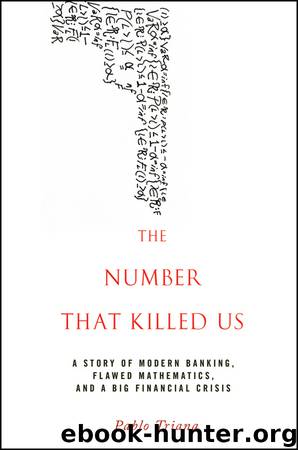The Number That Killed Us by Pablo Triana

Author:Pablo Triana
Language: eng
Format: epub
Publisher: Wiley
Published: 2011-10-29T04:00:00+00:00
It’s May 2011 as I am typing this. It’s more than 15 years since international regulators endowed VaR with the power to rule the world. During that period we’ve witnessed four or five mega–financial crises. Markets have gone through endless spells of crazy turbulence and absent liquidity. Venerated financial firms have sunk and been exterminated. Historical data has been proven unreliable. Correlations have betrayed us over and over. Volatility estimates have fooled us over and over. Mathematical finance in general disappointed mightily and enabled chaos. Prominent voices, including top policy makers, academics, and quants have vociferously lambasted VaR. The evidence against the model as an abetter of the 2007–2008 cataclysm is mounting by the day. You would figure that no one would want to touch VaR with a 10-foot pole, nor be seen within a thousand yards of it.
You would figure wrong. It’s May 2011 and VaR is still there. Still powerful, still influential, still commanding. Basel may have of late busied itself piling up add-on on top of add-on to the market risk regulatory capital formula, so as to try to make sure that trading book leverage going forward can’t be as insultingly superlative as it had been allowed to be up to mid-2007, but VaR is still the main part of that ever-so-influential formula. In fact, the presence of those Stressed VaR and Incremental Risk Charge add-ons (which, recall, are presumed to help lift capital requirements by three or four times their previous levels) may tempt banks to come up with even lower main VaR numbers, so that the final result (VaR plus the add-ons) is kept as humble as possible. We know that VaR is easily manipulable into being very small. So who can guarantee that banks can’t get even better at this after the crisis? Now they have a huge incentive to do so, after all. In any case, three–four times the prior capital charges is three–four times 1 percent or even 0.1 percent, not an insurmountably large number (250-to-1 leverage on trading positions may be less accommodating than 1,000-to-1 leverage, but it’s not less lethal). The revised formula that is intended to abort the type of cancerous results that VaR by itself can and did deliver can still deliver cancerous results.
What explains VaR’s resilience? It’d surely be nice to know.
Notes
1. “Trading Losses at Financial Institutions Underscore Need for Greater Market Risk Capital,” Standard & Poor’s (April 15, 2008).
2. Ranjit Lall, “Why Basel II Failed and Why Any Basel III Is Doomed,” Oxford University’s Global Economic Governance Programme Working Paper (October 2009).
3. Ibid.
4. Michel Crouhy et al., The Essentials of Risk Management (New York: McGraw-Hill, 2005), 359.
5. Nicholas Dunbar, Inventing Money (New York: John Wiley & Sons, 2001), 186.
6. Ibid., 147.
7. Ibid., 203.
8. Ibid., 204.
9. “Performance of Models-Based Capital Charges for Market Risk: 1 July–31 December 1998,” Basel Committee (September 1999).
10. Nicholas Dunbar, Inventing Money, 220.
11. “Financial Crisis Inquiry Commission Report,” (2011), Chapter 8.
12. Ibid.
Download
This site does not store any files on its server. We only index and link to content provided by other sites. Please contact the content providers to delete copyright contents if any and email us, we'll remove relevant links or contents immediately.
International Integration of the Brazilian Economy by Elias C. Grivoyannis(74782)
The Radium Girls by Kate Moore(11621)
Turbulence by E. J. Noyes(7700)
Nudge - Improving Decisions about Health, Wealth, and Happiness by Thaler Sunstein(7242)
The Black Swan by Nassim Nicholas Taleb(6764)
Rich Dad Poor Dad by Robert T. Kiyosaki(6175)
Pioneering Portfolio Management by David F. Swensen(6079)
Man-made Catastrophes and Risk Information Concealment by Dmitry Chernov & Didier Sornette(5647)
Zero to One by Peter Thiel(5488)
Secrecy World by Jake Bernstein(4388)
Millionaire: The Philanderer, Gambler, and Duelist Who Invented Modern Finance by Janet Gleeson(4094)
The Age of Surveillance Capitalism by Shoshana Zuboff(3983)
Skin in the Game by Nassim Nicholas Taleb(3965)
The Money Culture by Michael Lewis(3846)
Bullshit Jobs by David Graeber(3830)
Skin in the Game: Hidden Asymmetries in Daily Life by Nassim Nicholas Taleb(3723)
The Dhandho Investor by Mohnish Pabrai(3560)
The Wisdom of Finance by Mihir Desai(3523)
Blockchain Basics by Daniel Drescher(3329)
